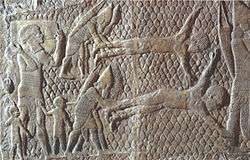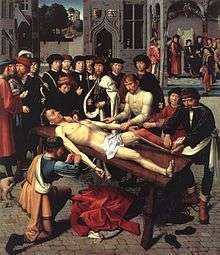Flaying

Flaying, also known colloquially as skinning, was a method of slow and painful execution in which skin is removed from the body. Generally, an attempt is made to keep the removed portion of skin intact.
Scope
A dead animal may be flayed when preparing it to be used as human food, or for its hide or fur. This is more commonly called skinning.
Flaying of humans is used as a method of torture or execution, depending on how much of the skin is removed. This is often referred to as "flaying alive". There are also records of people flayed after death, generally as a means of debasing the corpse of a prominent enemy or criminal, sometimes related to religious beliefs (e.g. to deny an afterlife); sometimes the skin is used, again for deterrence, magical uses, etc. (e.g. scalping).
Causes of death
Dermatologist Ernst G. Jung notes that the typical causes of death due to flaying are shock, critical loss of blood or other body fluids, hypothermia, or infections, and that the actual death is estimated to occur from a few hours up to a few days after the flaying.[2] Hypothermia is possible, as skin is essential for maintaining a person's body temperature, as it provides a person's natural insulation.
History
The Assyrian tradition

Ernst G. Jung, in his "Kleine Kulturgeschichte der Haut" ("A small cultural history of the skin"), provides an essay in which he outlines the Neo-Assyrian tradition of flaying human beings.[3] Already from the times of Ashurnasirpal II (r.883-859 BC), the practice is displayed and commemorated in both carvings and official royal edicts. The carvings show that the actual flaying process might begin at various places on the body, such as at the crus (lower leg), the thighs, or the buttocks.
In their royal edicts, the Neo-Assyrian kings seem to gloat over the terrible fate they imposed upon their captives, and that flaying seems, in particular, to be the fate meted out to rebel leaders. Jung provides some examples of this triumphant rhetoric, here are some from Ashurnasirpal II:
I have made a pillar facing the city gate, and have flayed all the rebel leaders; I have clad the pillar in the flayed skins. I let the leaders of the conquered cities be flayed, and clad the city walls with their skins. The captives I have killed by the sword and flung on the dung heap, the little boys and girls were burnt.
The Rassam Cylinder, in the British Museum demonstrates this.
Their corpses they hung on stakes, they stripped off their skins and covered the city wall with them.[4]
Other examples
Searing or cutting the flesh from the body was sometimes used as part of the public execution of traitors in medieval Europe. A similar mode of execution was used as late as the early 18th century in France; one such episode is graphically recounted in the opening chapter of Michel Foucault's Discipline and Punish (1979).
In 1303, the Treasury of Westminster Abbey was robbed while holding a large sum of money belonging to King Edward I. After arrest and interrogation of 48 monks, three of them, including the subprior and sacrist, were found guilty of the robbery and flayed. Their skin was attached to three doors as a warning against robbers of Church and State.[5] The Copford church in Essex, England has been found to have human skin attached to a door.[6]
In Chinese history, Sun Hao, Fu Sheng and Gao Heng were known for removing skin from people's faces.[7] The Hongwu Emperor flayed many servants, officials and rebels.[8][9] In 1396 he ordered the flaying of 5000 women.[10] Hai Rui suggested that his emperor flay corrupt officials. The Zhengde Emperor flayed six rebels,[11] and Zhang Xianzhong also flayed many people.[12] Lu Xun said the Ming Dynasty was begun and ended by flaying.[13]
The Aztecs of Mexico flayed victims of ritual human sacrifice, generally after death.
There are numerous reports of Native Americans flaying captives, seeking to keep them alive and suffering as long as possible.[14]
Examples and depictions of flayings


Mythological
- In Greek mythology, Marsyas, a satyr, was flayed alive for daring to challenge Apollo to a musical contest, which he lost.
- Also according to Greek mythology, Aloeus is said to have had his wife flayed alive.
- In Aztec mythology, Xipe Totec is the flayed god of death and rebirth. Slaves were flayed annually as sacrifices to him.
Historical
- Yahu-Bihdi, ruler of Hamath, was flayed alive by the Assyrians under Sargon II.
- According to Herodotus, Sisamnes, (a corrupt judge under Cambyses II of Persia), was flayed alive for accepting a bribe.
- The Talmud discusses how Rabbi Akiva was flayed alive by the Romans for the public teaching of Torah.
- Tradition holds that Saint Bartholomew was flayed before being crucified.
- Mani, founding prophet of Manichaeism, was said to have been flayed or beheaded (c. 275).
- In March 415, Hypatia of Alexandria, a Neoplatonist philosopher, was murdered by a Christian mob of Nitrian monks who accused her of paganism. They stripped her naked, skinned her with ostraca (pot shards), and then burned her remains.[15]
- Totila is said to have ordered the bishop of Perugia, Herculanus, to be flayed when he captured that city in 549.
- In 991 AD, during a Viking raid in England, a Danish Viking is said to have been flayed by London locals for ransacking a church. Alleged human skin found on a local church door has, for many years, been considered as proof for this legend, but a deeper analysis made during the production of the 2001 BBC documentary, Blood of the Vikings, came to the conclusion that the preserved skin came from a cow hide, and was part of a 19th-century hoax.
- Pierre Basile was flayed alive, and all defenders of the chateau hanged on 6 April 1199, by order of the mercenary leader Mercadier, for shooting and killing King Richard I of England with a crossbow at the siege of Châlus in March 1199.
- In 1314, the brothers d'Aulnoy, who were lovers to the daughters-in-law of king Philip IV of France, were flayed alive, then castrated and beheaded; and their bodies were exposed on a gibbet (Tour de Nesle Affair). The extreme severity of their punishment was due to the lèse majesté nature of the crime.
- In 1404 or 1417, the Hurufi Imad ud-Din Nesîmî, an Islamic poet of Turkic extraction, was flayed alive, apparently on orders of a Timurid governor, and for heresy.
- In August 1571, Marcantonio Bragadin, a defeated Venetian commander was flayed to death by the Ottomans, causing enormous outrage in Venice, and perhaps inspiring Titian's Flaying of Marsyas.[16]
- In 1657, the Polish Jesuit martyr, Andrew Bobola, was burned, half strangled, partly flayed alive, and killed by a sabre stroke by Eastern Orthodox Cossacks.
- In 1771, Daskalogiannis, a Cretan rebel against the Ottoman Empire, was flayed alive, and it is said that he suffered in dignified silence.
- In the United States, Nat Turner, leader of an unsuccessful slave rebellion, was hanged on November 11, 1831. His body was then flayed, beheaded, and quartered.
- The Rawhide Valley in Wyoming is said to have gotten its name from a white settler who was flayed alive there for murdering a Native American woman.
- In Marcel Ophüls's documentary, Hôtel Terminus: The Life and Times of Klaus Barbie, the daughter of a French Resistance leader claims her father was tortured, including being flayed, by Klaus Barbie during his time at Lyon, 1942-44.
Fictional
- In Thomas Harris's, The Silence of the Lambs, the character Buffalo Bill is a serial killer whose modus operandi includes flaying his victims.
- In the fantasy series, A Song of Ice and Fire, the Boltons of the Dreadfort flay their prisoners. The sigil of House Bolton is a flayed man. The Boltons allegedly gave up this practice a thousand years before the series begins; however, the sadistic bastard of the family, Ramsay Snow/Bolton, delights in flaying people and wants to restore its use.
- In Haruki Murakami’s novel, The Wind-Up Bird Chronicle, (1994-1995), the character Mamiya is traumatised by having witnessed a colleague being flayed to death in Manchukuo in the late 1930s.
- One of the plastinated exhibits in Body Worlds includes an entire posthumously flayed skin, and many of the other exhibits have had their skin removed.
See also
- Excarnation
- Anthropodermic bibliopegy (books bound in human skin)
References
- ↑ Dixon, John W. Jr. "The Terror of Salvation: The Last Judgment". Retrieved 2007-08-01.
- ↑ p.69 Kleine Kulturgeschichte der Haut. p. 69. Ernst G. Jung (2007).
- ↑ Paragraph based on the essay "Von Ursprung des Schindens in Assyrien" in Jung (2007), p.67-70
- ↑ Rassam Cylinder. The British Museum. & 636BC, pp. Col.1, L.52 to Col.2, L. 27.
- ↑ Andrews, William (1898). The Church Treasury of History, Custom, Folk-Lore, etc. London: Williams Andrews & Co. pp. 158–167. Retrieved 4 May 2015.
- ↑ Wall, J. Charles (1912), Porches and Fonts. Wells Gardner and Darton, London. pp. 41-42.
- ↑ . 中国死刑观察--中国的酷刑
- ↑ "也谈"剥皮实草"的真实性". Eywedu.com. Retrieved 2013-07-11.
- ↑ 覃垕曬皮
- ↑ 陈学霖(2001). 史林漫识. China Friendship Publishing Company.
- ↑ History of Ming, vol.94
- ↑ "写入青史总断肠(2)". Book.sina.com.cn. Retrieved 2013-07-11.
- ↑ 鲁迅. 且介亭雜文·病後雜談
- ↑ 'Empire of the Summer Moon', S.C. Gwynne; 'Son of the Morning Star', Evan S. Connell
- ↑ Edward Jay Watts, (2006), City and School in Late Antique Athens and Alexandria. "Hypatia and pagan philosophical culture in the later fourth century", pages 197–198. University of California Press
- ↑ Giovanni Mariotti, "La fine di Marsia secondo Tiziano", Il Corriere della Sera, 17 August 2003
![]() This article incorporates text from a publication now in the public domain: Chisholm, Hugh, ed. (1911). "article name needed". Encyclopædia Britannica (11th ed.). Cambridge University Press.
This article incorporates text from a publication now in the public domain: Chisholm, Hugh, ed. (1911). "article name needed". Encyclopædia Britannica (11th ed.). Cambridge University Press.
Bibliography
- Jung, Ernst G. (2007). "Von Ursprung des Schindens in Assyrien", in "Kleine Kulturgeschichte Der Haut". Springer Verlag. ISBN 9783798517578.
External links
| Wikimedia Commons has media related to Flaying. |